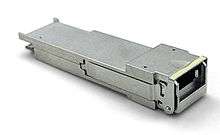QSFP

The Quad Small Form-factor Pluggable (QSFP) is a compact, hot-pluggable transceiver used for data communications applications. The form factor and electrical interface are specified by a multi-source agreement (MSA) under the auspices of the Small Form Factor Committee. It interfaces networking hardware (such as servers and switches) to a fiber optic cable or active or passive electrical copper connection. It is an industry format jointly developed and supported by many network component vendors, allowing data rates from 4x1 Gb/s for QSFP and 4x10 Gbit/s for QSFP+[1][2] and to the highest rate of 4x28 Gbit/s known as QSFP28[3] used for 100 Gbit/s links.
Types
QSFP transceivers are available with a variety of transmitter and receiver types, allowing users to select the appropriate transceiver for each link to provide the required optical reach over multi-mode or single-mode fiber. QSFP modules are commonly available in several different categories:
4 x 1 Gbit/s QSFP
The original QSFP document specified four channels carrying Gigabit Ethernet, 4GFC (FiberChannel), or DDR InfiniBand.[4]
4 x 10 Gbit/s QSFP+
QSFP+ is an evolution of QSFP to support four 10 Gbit/sec channels carrying 10 Gigabit Ethernet, 10GFC FiberChannel, or QDR InfiniBand.[5] The 4 channels can also be combined into a single 40 Gigabit Ethernet link. It is usually for the application of Data center, 40G Ethernet, Infiniband, and other communications standards. [6]
4 x 14 Gbit/s QSFP+ (QSFP14)
The QSFP14 standard is designed to carry FDR InfiniBand, SAS-3.[7] or 16G Fibre Channel
4 x 28 Gbit/s QSFP+ (QSFP28)
The QSFP28 standard is designed to carry 100 Gigabit Ethernet, EDR InfiniBand.[8] or 32G Fibre Channel. This transceiver type is also used with direct-attach breakout cables to adapt a single 100GbE port to four independent 25 gigabit ethernet ports (QSFP28-to-4x-SFP28).[9] Sometimes this transceiver type is also referred to as "QSFP100" or "100G QSFP" [10] for sake of simplicity.
Fanout
Switch and router manufacturers implementing QSFP ports in their products frequently allow for the use of a single QSFP port as four independent 10 gigabit ethernet connections, greatly increasing port density in a 1U height 24-port switch (24 40Gb ports x 4 = 96 10GbE).[11][12][13]
Pins
QSFP has 38 pins with 4 high-speed TX pairs (CML-I) and 4 high-speed RX pairs (CML-O).[14][15]
See also
- C Form-factor Pluggable (100 Gigabit Ethernet module)
- CXP (connector)
- OSFP transceiver slightly larger 400GbE transceiver standard
- Small form-factor pluggable transceiver (SFP)
References
- ↑ SFF Committee. "QSFP Public Specification" (PDF). SFF Committee. p. 12. Retrieved 22 June 2016.
- ↑ "What is QSFP+ Optics Transceiver". www.optcore.net. April 2017.
- ↑ SFF Committee (May 10, 2013). "SFF Committee Specification SFF-8665 for QSFP+ 28 Gb/s 4X Pluggable Transceiver Solution (QSFP28)" (PDF).
- ↑ SFF Committee. "QSFP Public Specification" (PDF). SFF Committee. p. 12. Retrieved 22 June 2016.
- ↑ SFF Committee. "QSFP+ 10 Gbs 4X Pluggable Transceiver" (PDF). p. 13. Retrieved 22 June 2016.
- ↑ "What is QSFP+ Optics Transceiver". www.optcore.net. April 2017.
- ↑ SFF Committee. "QSFP+ 14 Gb/s 4X Pluggable Transceiver Solution (QSFP14)" (PDF). p. 5. Retrieved 22 June 2016.
- ↑ SFF Committee. "QSFP+ 28 Gb/s 4X Pluggable Transceiver Solution" (PDF). p. 5. Retrieved 22 June 2016.
- ↑ "QSFP28-to-SFP28 breakout".
- ↑ "Arista "100G Optics and Cabling Q&A Document"" (PDF). www.arista.com. Arista Networks, Inc.
- ↑ "Cisco Nexus 5600 specifications".
- ↑ "Finisar 4 x 10GbE fanout QSFP".
- ↑ "Arista 40Gb port to 4 x 10GbE breakout" (PDF).
- ↑ INF-8438i Specification for QSFP (Quad Small Formfactor Pluggable) Transceiver Rev 1.0 November 2006
- ↑ SFF-8436 Specification for QSFP+ 10 Gbs 4X PLUGGABLE TRANSCEIVER Rev 4.8 October 31, 2013